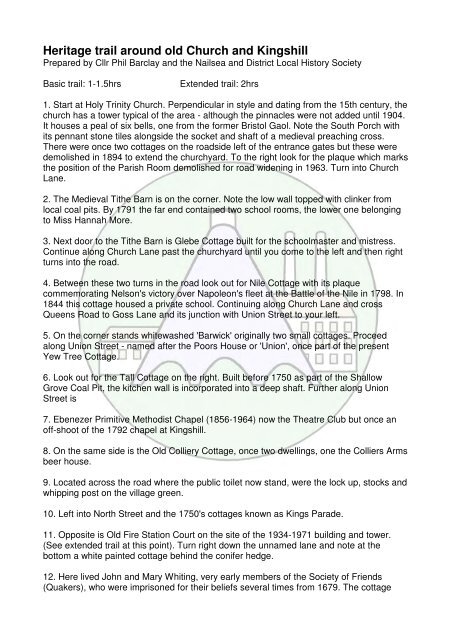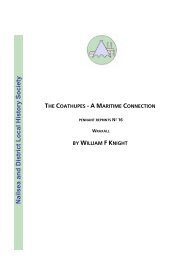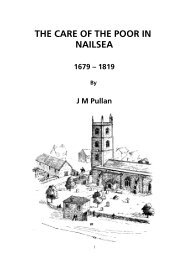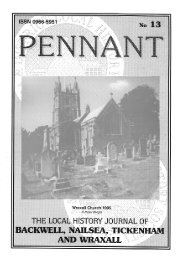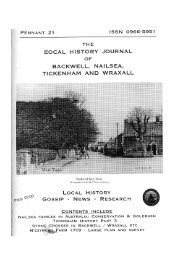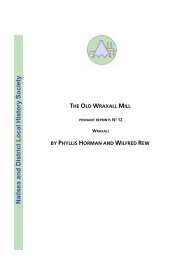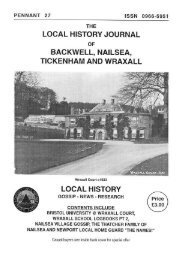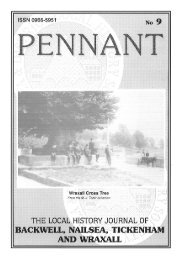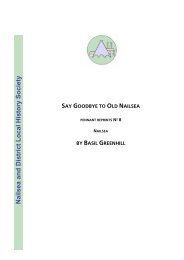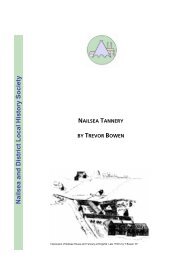Here - Nailsea and District Local History Society
Here - Nailsea and District Local History Society
Here - Nailsea and District Local History Society
You also want an ePaper? Increase the reach of your titles
YUMPU automatically turns print PDFs into web optimized ePapers that Google loves.
Heritage trail around old Church <strong>and</strong> KingshillPrepared by Cllr Phil Barclay <strong>and</strong> the <strong>Nailsea</strong> <strong>and</strong> <strong>District</strong> <strong>Local</strong> <strong>History</strong> <strong>Society</strong>Basic trail: 1-1.5hrsExtended trail: 2hrs1. Start at Holy Trinity Church. Perpendicular in style <strong>and</strong> dating from the 15th century, thechurch has a tower typical of the area - although the pinnacles were not added until 1904.It houses a peal of six bells, one from the former Bristol Gaol. Note the South Porch withits pennant stone tiles alongside the socket <strong>and</strong> shaft of a medieval preaching cross.There were once two cottages on the roadside left of the entrance gates but these weredemolished in 1894 to extend the churchyard. To the right look for the plaque which marksthe position of the Parish Room demolished for road widening in 1963. Turn into ChurchLane.2. The Medieval Tithe Barn is on the corner. Note the low wall topped with clinker fromlocal coal pits. By 1791 the far end contained two school rooms, the lower one belongingto Miss Hannah More.3. Next door to the Tithe Barn is Glebe Cottage built for the schoolmaster <strong>and</strong> mistress.Continue along Church Lane past the churchyard until you come to the left <strong>and</strong> then rightturns into the road.4. Between these two turns in the road look out for Nile Cottage with its plaquecommemorating Nelson's victory over Napoleon's fleet at the Battle of the Nile in 1798. In1844 this cottage housed a private school. Continuing along Church Lane <strong>and</strong> crossQueens Road to Goss Lane <strong>and</strong> its junction with Union Street to your left.5. On the corner st<strong>and</strong>s whitewashed 'Barwick' originally two small cottages. Proceedalong Union Street - named after the Poors House or 'Union', once part of the presentYew Tree Cottage.6. Look out for the Tall Cottage on the right. Built before 1750 as part of the ShallowGrove Coal Pit, the kitchen wall is incorporated into a deep shaft. Further along UnionStreet is7. Ebenezer Primitive Methodist Chapel (1856-1964) now the Theatre Club but once anoff-shoot of the 1792 chapel at Kingshill.8. On the same side is the Old Colliery Cottage, once two dwellings, one the Colliers Armsbeer house.9. Located across the road where the public toilet now st<strong>and</strong>, were the lock up, stocks <strong>and</strong>whipping post on the village green.10. Left into North Street <strong>and</strong> the 1750's cottages known as Kings Parade.11. Opposite is Old Fire Station Court on the site of the 1934-1971 building <strong>and</strong> tower.(See extended trail at this point). Turn right down the unnamed lane <strong>and</strong> note at thebottom a white painted cottage behind the conifer hedge.12. <strong>Here</strong> lived John <strong>and</strong> Mary Whiting, very early members of the <strong>Society</strong> of Friends(Quakers), who were imprisoned for their beliefs several times from 1679. The cottage
elieved to be the first Quaker Meeting House in North Somerset st<strong>and</strong>s on the formervillage green which was bounded by North Street, Watery Lane (where you now st<strong>and</strong>)<strong>and</strong> Kingshill.13. Tudor House on the corner of Watery Lane <strong>and</strong> Kingshill was the Bird in the H<strong>and</strong>public house between 1902-1966. Look opposite <strong>and</strong> you will see.14. Two modern houses. This site was the Tannery between 1696 <strong>and</strong> 1890. It suppliedleather to a flourishing boot, clog <strong>and</strong> shoe cottage industry centred around Kingshill <strong>and</strong>Silver Street in the 1800s. Take a left turn along a track <strong>and</strong> public footpath around a highwall.15. <strong>Here</strong> is <strong>Nailsea</strong> House. You can see through the gates one of the milestonesexcavated from the Tannery. Walk a few yards on <strong>and</strong>16. Look through the gates of Old Kingshill Court - you can just see the chimney <strong>and</strong> whitegable wall of Old Kingshill Farm House beyond the trees. When its thatched roof wasreplaced a receipt was found possibly indicating that some of Cromwell's CommonwealthTroops lodged here in 1643. Retrace your steps to Kingshill <strong>and</strong> cross the road. Look outfor a footpath alongside No.18.17. On this corner was the Poors House used as such until 1871.18. Continue down the footpath, past the site of Kinghill Pit (c.1800-1820) <strong>and</strong> into ChapelBarton.19. Opposite is reputedly the first Wesleyan Methodist Chapel in North Somerset built in1792. Now extended as the <strong>Nailsea</strong> Social Club, much of its early congregation heredrawn from the families of coal miners <strong>and</strong> glassworkers. Turn right until you get to the20. Moorend Spout Public House (formerly the Butchers Arms c.1735). If you wish toextend your walk at this point see * at the end otherwise return along Union Street. Alongthe way look out for21. Early Council Houses named Forty Fathoms after the coal pit which operated hereuntil 1830.*The Extended WalkThis route will take you along unmade footpaths <strong>and</strong> suitable footwear is recommended.From the Moorend Spout Public House continue along North Street <strong>and</strong> turn right into FirLeaze, then left into North Lane. Note the tall cottage which was converted from a collieryengine house. Turn left at the Public Footpath sign <strong>and</strong> follow the public right of waythrough the garden of No.8 respecting the owner's privacy. Continue through the orchardkeeping to the conifer hedge <strong>and</strong> cross the Parish Brook via the stone style. Follow thebrook to the right to emerge on The Causeway. Note the long, narrow strip of l<strong>and</strong> to yourleft, purchased for a canal to serve the coal mines <strong>and</strong> glass works but never built.Causeway House on your left <strong>and</strong> take the public footpath on the right skirting the edge ofthe stables. Cross the brook via the stile <strong>and</strong> then via a further field to another stile <strong>and</strong>Causeway View. Cross over the road <strong>and</strong> continue via the footpath to rejoin the shortertrail at Old Kingshill Court <strong>and</strong> <strong>Nailsea</strong> House.


